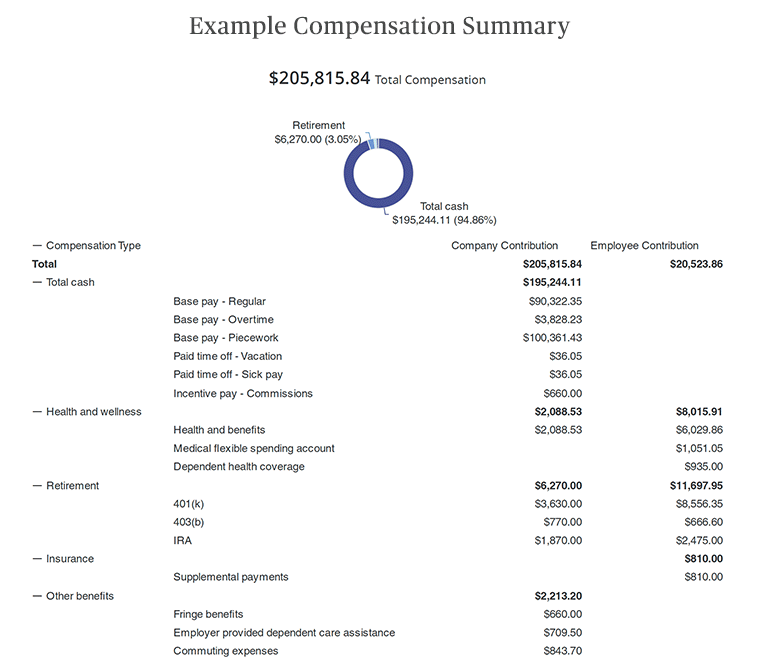- Recursos humanos
- Artículo
- Lectura de 6 minutos
- Last Updated: 10/20/2023
How To Calculate Total Compensation for Employees

Table of Contents
In the minds of your employees, compensation may be a term interchangeable with the amount in their paychecks. But when examined in detail, the definition of total compensation goes beyond hourly wages or salaries. When managing compensation, employers may choose to balance the expense associated with certain benefit programs against increased employee wages. While coming up with an estimate of total pay plus benefits on a monthly or annual basis may seem difficult, compensation calculations can help demonstrate the true value of everything employees receive in exchange for their hard work.
What Is a Total Compensation Package?
Companies should build written compensation plans to provide guidance and standardization across business lines. A well-rounded plan should consider all forms of compensation, from base pay to bonuses, incentives, and benefits.
Each employee should receive a total compensation package that aligns with the policies and guidance in the compensation plan. The compensation package generally includes both monetary payments and other forms of indirect compensation. Monetary payments, or direct compensation, typically include salary or hourly pay, commissions, and incentives. Indirect, or non-monetary compensation covers employee benefits such as paid time off (PTO), health insurance, retirement savings, and fringe benefit plans like employee wellness programs or legal benefits. The cost of career development programs or company training may also be included in the indirect compensation category. When calculating total compensation, the quantified value of non-monetary benefits should be added to direct compensation.
Total Compensation vs. Salary
Employers spend more than paycheck dollars when providing compensation for employees. Health care expenses, commuter benefits, and other perks can make a significant impact on the annual budget of a business. But no company wants to waste money on unused or undesired benefits. Understanding this difference between an employee's pay versus the total amount of compensation can help employers ensure they're spending compensation dollars wisely, in a manner that attracts and retains talent.
When evaluating job offers or promotions, prospective employees may want to understand an offer’s compensation package rather than simply a salary or hourly rate. For example, when weighing two competing offers, an employee may consider the job with a stronger health care benefits program or better retirement benefits to be more valuable than the opportunity that offers a slight increase in annual pay. You may not be able to present a job candidate with a full total compensation report, but providing an overview of what their compensation might entail (e.g., health benefits or equity options) could give you a competitive advantage over employers who merely report a target salary.
Why It’s Important To Know How Much Your Compensation Package Is Worth
Understanding the true value of compensation helps employers to budget, plan, and choose the best benefits programs. A total compensation plan can illustrate the value of different benefit programs and highlight any unique perks your company offers.
As some benefits are not easily quantifiable, employees may tend to focus primarily on payroll dollars and pay less attention to important benefits they could take advantage of during the year. Some workers consider health benefits as a necessity, so they don't spend much time comparing one plan's value against another. Additionally, smaller companies that may need to stretch their compensation budget to remain competitive can use a plan to demonstrate their commitment to their employees by showcasing the value of their benefits along with the wages they offer.

*Example Compensation Summary provided for demonstration purposes only.
How To Calculate Total Employee Compensation
When calculating an employee’s total compensation, you'll need to include all sources of direct and indirect pay.
Direct Pay
Begin with direct sources, which may include the following:
Base Pay
An employee's base pay is the agreed-upon amount that they are entitled to receive for their work. This is usually expressed as an annual salary or an hourly pay rate.
Additional Pay
Additional pay represents any form of direct pay the employee receives in addition to their base pay, such as overtime pay, incentives, commissions, and bonuses. The amounts may vary based on what the law requires or employee performance, or be given in accordance with an employment contract.
Indirect Pay
To complete the total compensation calculation, add the value of indirect items, such as:
- Health benefits
- Retirement benefits
- Tuition assistance
- Wellness programs
- Cellphone allowance
- Parking fee reimbursements
- Costs related to using a company car
Any documentation of the total compensation should contain a line item for each direct and indirect amount. Once the cost of each item has been determined, they can be added together to arrive at the total compensation for the employee.
Stay Competitive by Knowing the Worth of Your Compensation Package
Top employers make a significant investment in their employees that goes beyond base wages. Implementing HR strategies that optimize total compensation for each employee can help your business remain competitive and attract the best talent in your industry. If you need further assistance with compensation planning or calculating total compensation, our HR services experts are here to provide support and guidance.
Tags










